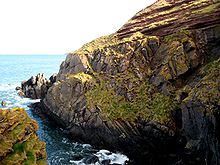The examples and perspective in this article deal primarily with the United Kingdom and do not represent a worldwide view of the subject. (August 2024) |
| Old Red Sandstone | |
|---|---|
| Stratigraphic range: Late Silurian – earliest Carboniferous | |
 Folded Old Red Sandstone rock formation at St Ann's Head in Pembrokeshire, Wales | |
| Type | Supergroup |
| Sub-units | See text |
| Thickness | More than 4 km (2.5 mi) (Shetland) |
| Lithology | |
| Primary | Sandstone |
| Other | Conglomerate, shale, mudstone, siltstone, limestone |
| Location | |
| Region | North Atlantic |
| Country | Canada, Greenland, Ireland, Norway, United Kingdom |
| Extent | 700 km (430 mi)[1] |

Old Red Sandstone, abbreviated ORS, is an assemblage of rocks in the North Atlantic region largely of Devonian age. It extends in the east across Great Britain, Ireland and Norway, and in the west along the eastern seaboard of North America. It also extends northwards into Greenland and Svalbard.[3] These areas were a part of the paleocontinent of Euramerica (Laurussia). In Britain it is a lithostratigraphic unit (a sequence of rock strata) to which stratigraphers accord supergroup status[4] and which is of considerable importance to early paleontology. The presence of Old in the name is to distinguish the sequence from the younger New Red Sandstone which also occurs widely throughout Britain.
- ^ Cite error: The named reference
Barclaywas invoked but never defined (see the help page). - ^ Cite error: The named reference
FieldExcursionwas invoked but never defined (see the help page). - ^ Friend, P.F. and Williams, B.P.J. (eds) 2000 New Perspectives on the Old Red Sandstone. Geological Society, London, Special publications 180 p1,35
- ^ http://www.bgs.ac.uk/Lexicon/lexicon.cfm?pub=ORS entry in BGS on-line rock lexicon